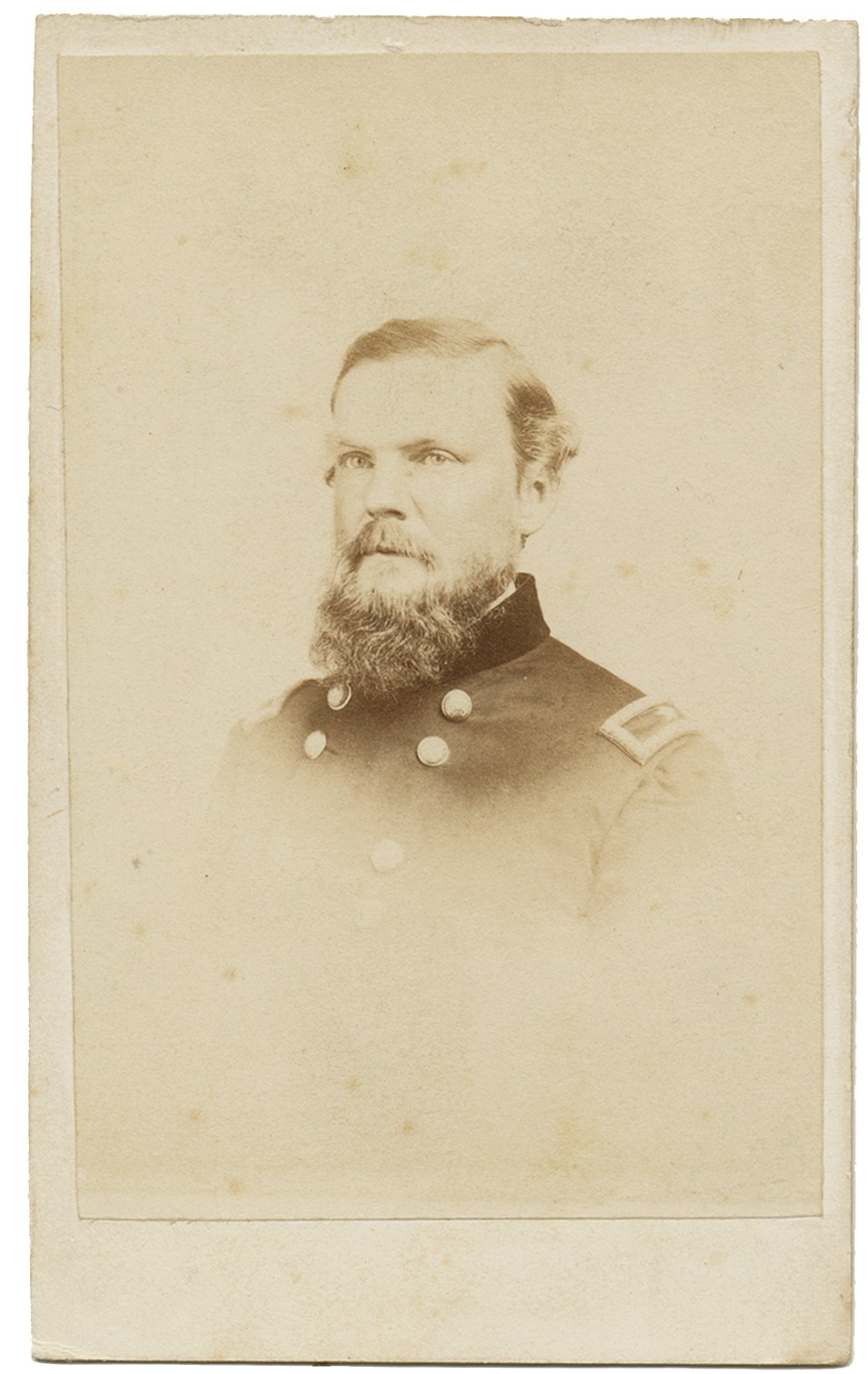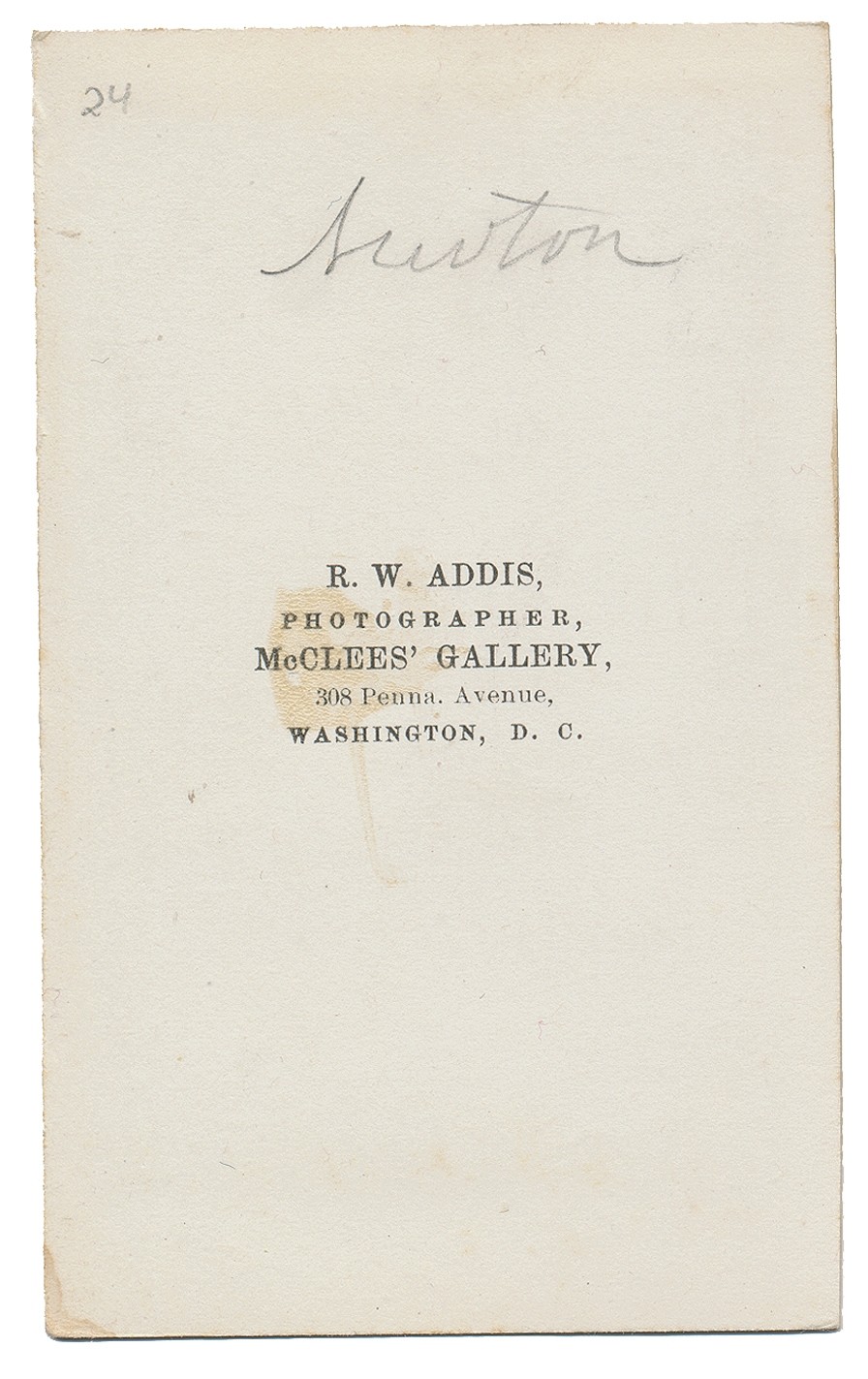site search
online catalog
BUST CDV IMAGE OF GENERAL JOHN NEWTON-TOOK COMMAND OF 1ST CORPS AFTER DEATH OF REYNOLDS AT GETTYSBURG

Hover to zoom


$224.00 SOLD
Originally $280.00
Quantity Available: None
Item Code: 259-48
Image shows Newton in the uniform of a brigadier general.
Contrast and clarity are excellent. Paper and mount have light surface dirt only.
Reverse has photographer’s imprint for R.W. ADDIS… WASHINGTON, D. C. There is also a penciled inscription that could be period that reads “NEWTON.”
Born at Norfolk, VA on August 25, 1822, Newton attended school in Norfolk and then decided to pursue a military career entering West Point in 1838.
Newton graduated second in the Class of 1842 and accepted a commission in the Corps of Engineers. He taught engineering at West Point for three years. In 1846, Newton was assigned to construct fortifications along the Atlantic coast and Great Lakes.
Four years later, he received a promotion to first lieutenant. Named to a board tasked with assessing the defenses on the Gulf Coast in 1856, he was promoted to captain on July 1 of that year. Newton conducted surveys for harbor improvements in Florida and served as superintending engineer for Forts Pulaski in Georgia and Jackson in Louisiana.
In 1858, Newton was made the chief engineer of the Utah Expedition under command of then Colonel Albert S. Johnston. Newton then served as superintending engineer at Forts Delaware and Mifflin on the Delaware River. With the election of President Abraham Lincoln in 1860, Newton decided to remain loyal to the Union.
Made Chief Engineer of the Department of Pennsylvania, Newton first saw action during a skirmish at Hoke's Run on July 2, 1861. After briefly serving as Chief Engineer of the Department of the Shenandoah, he arrived in Washington, DC in August and aided in constructing defenses in that city and in Alexandria. Promoted to brigadier general on September 23, Newton assumed command of a brigade in the growing Army of the Potomac.
After service in Major General Irvin McDowell's I Corps, his men were ordered to join the newly-formed VI Corps in May 1862.
Newton took part in McClellan's Peninsula Campaign. Serving in Slocum's division, his brigade saw action in late June as General Robert E. Lee opened the Seven Days' Battles. Newton performed well at both Gaines' Mill and Glendale.
With the failure of Union efforts on the Peninsula, the VI Corps returned to Washington before taking part in the Maryland Campaign. Going into action on September 14 at South Mountain, Newton distinguished himself by personally leading a bayonet attack against a Confederate position at Crampton's Gap. Three days later he took part in the battle of Antietam and for his performance in the fighting there, he received a brevet promotion to lieutenant colonel in the regular army. Later that fall, Newton was elevated to lead the VI Corps' Third Division.
At Fredericksburg on December 13 the VI Corps was largely idle during the fighting. After the battle Newton traveled to Washington to voice his concerns about General Burnside to Lincoln. Newton commented that there was a "want of confidence in General Burnside's military capacity" and that "the troops of my division and of the whole army had become entirely dispirited." Burnside was dismissal in January 1863 and Major General Joseph Hooker took his place as commander of the Army of the Potomac. Promoted to major general on March 30, Newton led his division during the Chancellorsville Campaign that May.
During the battle of Gettysburg Newton was ordered to assume command of the I Corps after the death of Reynolds. Relieving Major General Abner Doubleday, Newton directed the I Corps during the Union defense of Pickett's Charge on July 3. Retaining command of the Corps through the fall, he led it during the Bristoe and Mine Run Campaigns. The spring of 1864 proved difficult for Newton as a reorganization of the Army of the Potomac led to the I Corps being dissolved. Additionally, due to his role in Burnside's removal, Congress refused to confirm his promotion to major general. As a result, Newton reverted to brigadier general on April 18.
Sent west, Newton assumed command of a division in the IV Corps. Serving in Army of the Cumberland, he took part in Sherman's advance on Atlanta. Newton's division distinguished itself at Peachtree Creek on July 20 when it blocked multiple Confederate assaults. Newton continued to perform well through the fall of Atlanta in early September.
With the end of the campaign, Newton received command of the District of Key West and Tortugas. He was checked by Confederate forces at Natural Bridge in March 1865. Remaining in command for the rest of the war, Newton held a series of administrative posts in Florida into 1866. Leaving the volunteer service in January 1866, he accepted a commission as a lieutenant colonel in the Corps of Engineers.
Newton spent the better part of the next two decades engaged in a variety of engineering and fortification projects in New York.
On March 6, 1884, he was promoted to brigadier general and made Chief of Engineers. He retired on August 27, 1886 and served as Commissioner of Public Works of New York City until 1888 before becoming President of the Panama Railroad Company. Newton died in New York City on May 1, 1895 and was buried at West Point National Cemetery. [ad] [ph:L]
~~~~~~~~~~~~~~~~~~~~~~~~~~~~~~~~~~~
THIS ITEM, AS WITH ALL OTHER ITEMS AVAILABLE ON OUR WEB SITE,
MAY BE PURCHASED THROUGH OUR LAYAWAY PROGRAM.
CLICK HERE FOR OUR POLICIES AND TERMS.
THANK YOU!
Inquire About BUST CDV IMAGE OF GENERAL JOHN NEWTON-TOOK COMMAND OF 1ST CORPS AFTER DEATH OF REYNOLDS AT GETTYSBURG
Most Popular
Historical Firearms Stolen From The National Civil War Museum In Harrisburg, Pa »
Theft From Gravesite Of Gen. John Reynolds »
Selection Of Unframed Prints By Don Troiani »
Fine Condition Brass Infantry Bugle Insignia »
featured item
RARE 1/6 PLATE AMBROTYPE – LT. JOHN WHITEHEAD, 53rd VA, WIA AND CAPTURED DURING PICKETT’S CHARGE – EX-COCO COLLECTION
The 53rd Virginia Infantry Regiment participated in the Battle of Gettysburg as part of General Armistead's Brigade and played a famous role in Pickett's Charge on July 3, 1863, with some men advancing to the stone wall along the Angle before being… (1300-74). Learn More »
site search
Upcoming Events
The shop is currently closed so that we may conduct our annual inventory. We are available by phone… Learn More »


